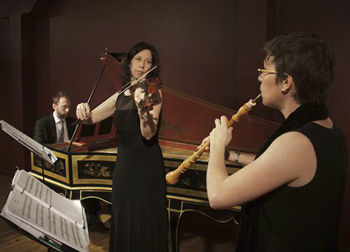by Nicholas Jones

In its recent program of innovative French chamber music from the late 18th century, Les Délices, spearheaded by founder, music director, and oboist Debra Nagy, has once again brought us lovely and barely-known gems from this age of transition. The music was presented with virtuosity and enthusiasm, making for a thoroughly gratifying Sunday afternoon in Herr Chapel at Plymouth Church.
In recent concerts, Nagy has presented several pieces by François-André Philidor, better known in his time as a master of the game of chess, but now being rediscovered as a composer of startling innovation. This program began and ended with substantive “sinfonias” by Philidor, multi-movement pieces that brought together the virtuosity of Italianate music, the ornamental sparkle of the French, and the innovations of the Austrian (surely, Philidor had heard some early Haydn). Chromaticisms and surprising modulations led us on eyebrow-raising excursions far from the home key, though we never were left in doubt that order would be gracefully restored before the end.
In the Philidor pieces, the three treble lines were played by Nagy (oboe) and Julie Andrijeski and Karina Schmitz (violins). The basso continuo was handled with consummate flair by gambist Emily Walhout and harpsichordist Michael Sponseller, both regulars with Les Délices. The ensemble throughout the concert was lithe, flexible, responsive, and utterly secure. The program felt so well-rehearsed in part because the group had already spent several days recording the material for a CD, hopefully to be released next year.
A sonata from 1743 by Louis-Gabriel Guillemain came to us from his publication entitled, appropriately, Conversations Galantes — the name evoking the kind of back-and-forth that might have occurred at the aristocratic and intellectual salons of the mid-century. In the sprightly, amused interchanges amongst the instruments, we could imagine a kind of knowing and elegant banter. (“What a pleasant ride we had this morning! … Oh, that silk waistcoat looks so chic on you! … Wasn’t it fun to play blind-man’s-buff in the twilight?”) We might well have been in one of Fragonard’s paintings, with their combination of courtly pleasure and melancholy awareness of the incipient ending of privilege.
Two pieces for harpsichord by Jacques Duphly (who died in the very year of the Revolution) combined the elegant ornamentation of earlier French keyboard music with an intensity that prefigured Mozart and even (dare I say it?) Beethoven. The second of these was a sketch which, though called “Le Félix,” seemed far from merely “happy” — played low in the register with all the stops out and the manuals doubled, it evoked a curmudgeonly character with a magnetic energy. Michael Sponseller delivered the Duphly solos with stunning expressivity.
One of the principal instruments of the French 18th century was the flute, so it is understandable that Nagy would borrow flute pieces and adapt them for the oboe. This one was a work by flutist Michel Blavet (Op. 2, No. 2). Full of intricate passages and lovely melodies, this five-movement piece showed Nagy’s musical sensitivity as well as her sheer technical skill. Throughout the performance, though, I found myself wishing for the more nuanced and intimate sounds of the flute for which it was originally intended.
One of the most popular tunes of the day was “Les Sauvages,” a politically-incorrect but highly memorable dance from Jean-Phillipe Rameau’s opera Les Indes Galantes. Here violinists Andrijeski and Schmitz teamed up without accompaniment for a splendid set of variations by Jean-Pierre Guignon on themes from the opera. The original tune was manic enough, but this duet, with its duelling scale passages and sudden shifts of affect, took the piece’s inherent energy to new heights — and with virtuoso playing by both violinists.
The little-known music that Nagy brings to Les Délices is a joy to listen to. That said, it is telling in the midst of such an exploratory program to encounter once again the masterful music of a canonical figure like Rameau. From his opera Les Boréades, we heard the hauntingly beautiful “Entrée de Polymnie,” with its languishing descending scales and poignant touches of melancholy. In a very different vein, the ensemble played the Chaconne from another Rameau opera, Dardanus — full of grand gestures, sudden variations of tone, and an assertive and highly public rhetoric — as if admonishing its jaded aristocratic audience to sit up and take notice!
Three more inventive programs from Les Délices await us this season, in January, February, and May, as well as a free family-oriented “petting-zoo” concert at the Bop Stop in February.
Published on ClevelandClassical.com November 10, 2015.
Click here for a printable copy of this article



